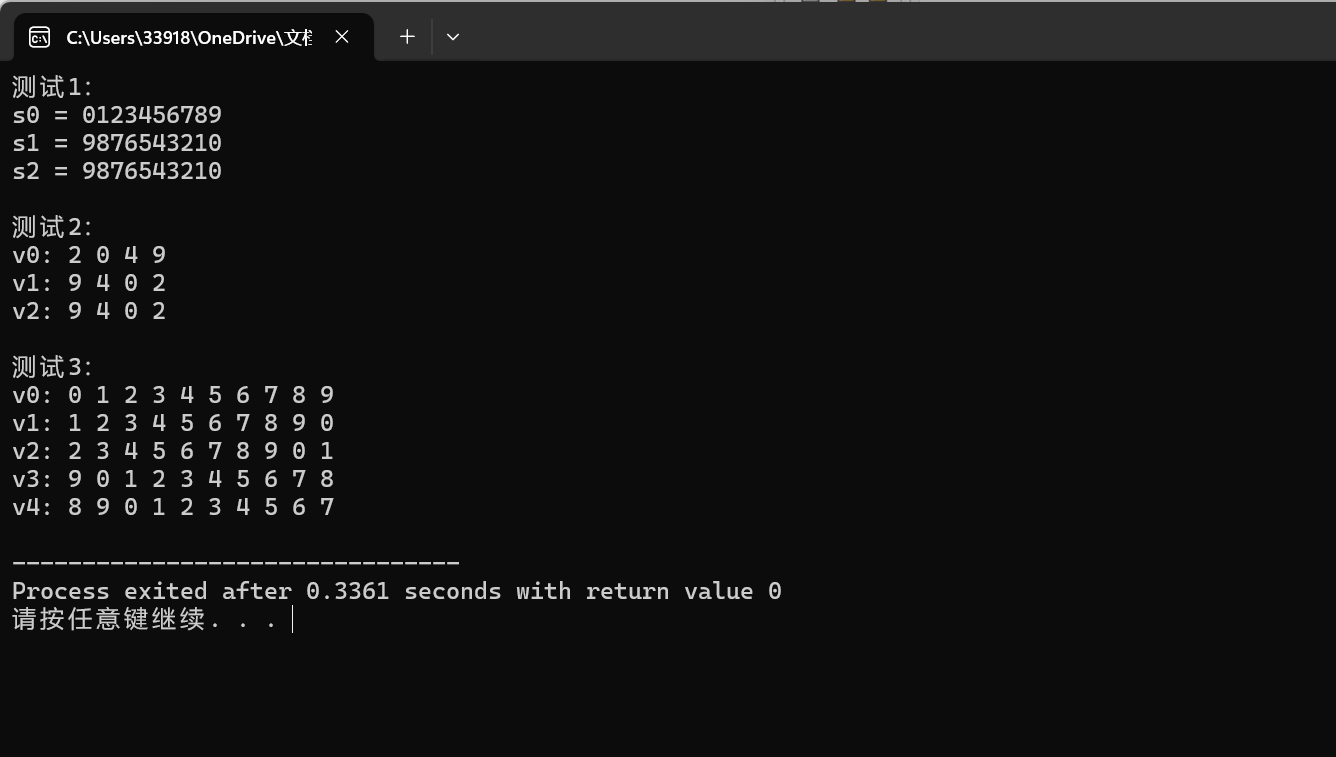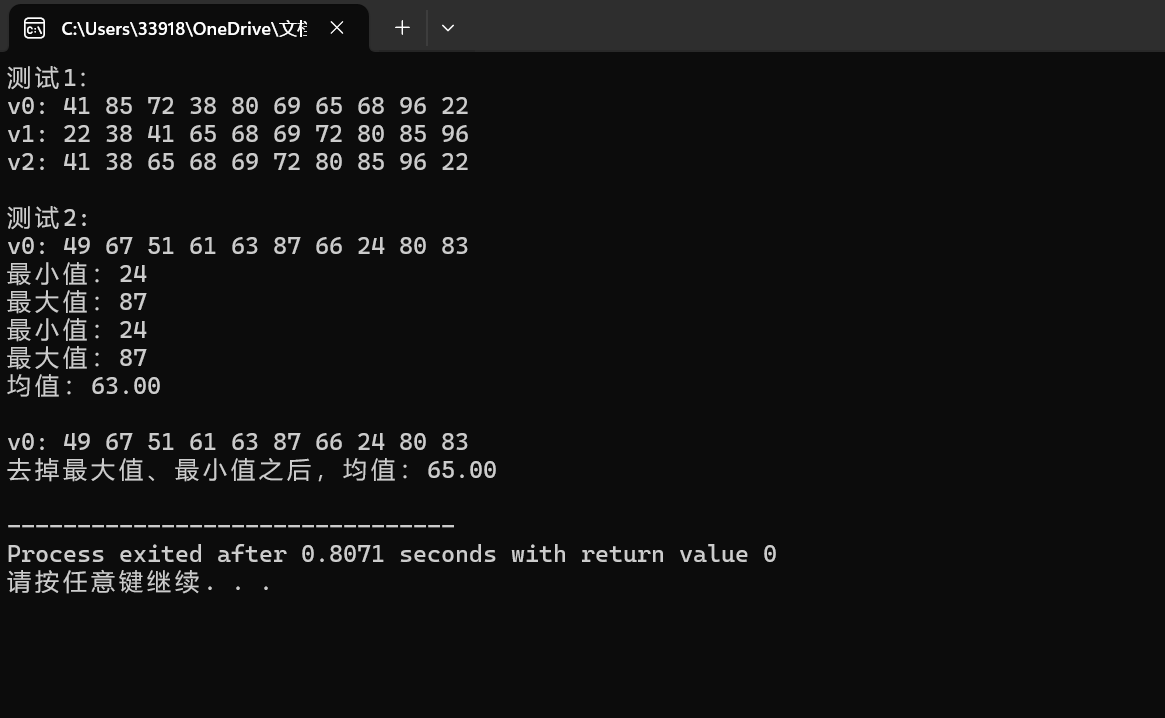实验一,现代C++编程初体验
一、实验目的
体验C++的标准库,算法库用法。数据表示,分支循环,函数和标准库等,编程解决简单基础问题。
二、实验准备
第二章C++语言简单设计
第三章函数
第九章 函数模板
三、实验内容
1. 实验任务1
代码:
1 #include<iostream> 2 #include<string> 3 #include<vector> 4 #include<algorithm> 5 6 using namespace std; 7 8 template <typename T> 9 void output (const T &c); 10 void test1(); 11 void test2(); 12 void test3(); 13 14 int main(){ 15 cout <<"测试1:\n" ; 16 test1(); 17 18 cout <<"\n测试2:\n"; 19 test2(); 20 21 cout <<"\n测试3:\n"; 22 test3(); 23 24 25 } 26 template <typename T> 27 void output(const T &c){ 28 for (auto &i:c) 29 cout << i << " "; 30 cout <<endl; 31 32 } 33 void test1(){ 34 string s0{"0123456789"}; 35 cout <<"s0 = "<<s0<<endl; 36 37 string s1{s0}; 38 reverse(s1.begin(), s1.end()); 39 cout <<"s1 = "<<s1<<endl; 40 41 string s2{s0}; 42 reverse_copy(s0.begin(),s0.end(),s2.begin()); 43 44 cout << "s2 = "<<s1<<endl; 45 } 46 47 void test2() 48 { 49 vector <int> v0{2,0,4,9}; 50 cout<<"v0: "; 51 output(v0); 52 53 vector<int> v1{v0}; 54 reverse(v1.begin(),v1.end()); 55 cout <<"v1: "; 56 output(v1); 57 58 vector<int> v2{v0}; 59 reverse_copy(v0.begin(),v0.end(),v2.begin()); 60 cout<<"v2: "; 61 output(v2); 62 } 63 64 void test3(){ 65 vector<int> v0{0,1,2,3,4,5,6,7,8,9}; 66 cout<<"v0: " ; 67 output(v0); 68 69 vector<int> v1{v0}; 70 rotate(v1.begin(),v1.begin()+1,v1.end()); 71 cout << "v1: "; 72 output(v1); 73 74 vector<int>v2{v0}; 75 rotate(v2.begin(),v2.begin()+2,v2.end()); 76 cout<<"v2: "; 77 output(v2); 78 79 vector<int> v3{v0}; 80 rotate(v3.begin(),v3.end()-1,v3.end()); 81 cout <<"v3: " ; 82 output(v3); 83 84 vector<int>v4{v0}; 85 rotate (v4.begin(),v4.end()-2,v4.end( )); 86 cout<<"v4: "; 87 output(v4); 88 89 } 90 91 92
运行截图:

问题回答:
2. 实验任务2
代码:
1 #include<iostream> 2 #include<vector> 3 #include<string> 4 #include<algorithm> 5 #include<numeric> 6 #include<iomanip> 7 8 9 using namespace std; 10 11 template < typename T> 12 void output (const T&c); 13 14 15 int rand_int_100(); 16 void test1(); 17 void test2(); 18 19 int main(){ 20 cout << "测试1:\n"; 21 test1(); 22 23 cout<<"\n测试2: \n"; 24 test2(); 25 26 } 27 28 template <typename T> 29 void output (const T&c){ 30 31 for (auto &i:c) 32 cout<< i << " "; 33 cout<<endl; 34 } 35 36 37 int rand_int_100(){ 38 39 return rand()%101; 40 41 } 42 43 void test1(){ 44 vector<int> v0(10); 45 generate(v0.begin(),v0.end(),rand_int_100); 46 cout << "v0: "; 47 output(v0); 48 vector<int> v1{v0}; 49 sort(v1.begin(),v1.end()); 50 51 cout << "v1: "; 52 output(v1); 53 54 vector <int> v2{v0}; 55 sort(v2.begin()+1,v2.end()-1); 56 57 cout << "v2: "; 58 output(v2); 59 60 } 61 62 void test2(){ 63 64 65 vector <int> v0(10); 66 generate(v0.begin(),v0.end(),rand_int_100); 67 cout<< "v0: "; 68 output(v0); 69 70 auto iter1 = min_element (v0.begin(),v0.end()); 71 cout<<"最小值:"<< *iter1<<endl; 72 73 auto iter2 = max_element(v0.begin(),v0.end()); 74 cout<<"最大值:"<< *iter2<<endl; 75 76 auto ans = minmax_element(v0.begin(),v0.end()); 77 cout<<"最小值:"<< *(ans.first)<<endl; 78 cout<<"最大值:"<<*(ans.second)<<endl; 79 double avg1= accumulate (v0.begin(),v0.end(),0)/v0.size(); 80 cout<<"均值:"<<fixed<<setprecision(2)<<avg1<<endl; 81 82 cout << endl; 83 vector <int> v1{v0}; 84 cout<<"v0: "; 85 output(v0); 86 sort(v1.begin(),v1.end()); 87 double avg2 = accumulate (v1.begin()+1,v1.end()-1,0)/(v1.size()-2); 88 cout<<"去掉最大值、最小值之后,均值:"<<avg2<<endl; 89 90 } 91
运行截图:

问题回答:
3. 实验任务3
代码:
运行截图:
问题回答:
4. 实验任务4
代码:
运行截图:
问题回答:
5. 实验任务5
代码:
运行截图:
问题回答:
6. 实验任务6
代码:
运行截图:
问题回答:
7. 实验任务7
代码:
运行截图:
问题回答:
8. 实验任务8
代码:
运行截图:
问题回答:
四、实验结论
1. 实验任务1
2. 实验任务2
3. 实验任务3
4. 实验任务4
5. 实验任务5
6. 实验任务6
7. 实验任务7
8. 实验任务8
五、实验总结(选)